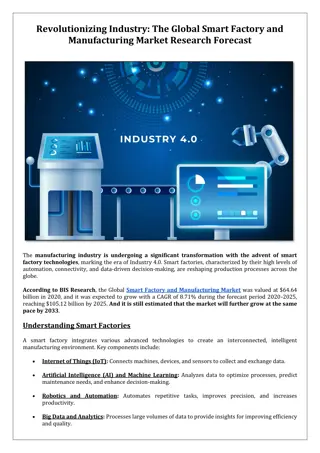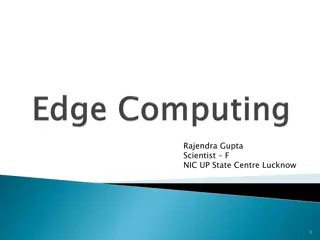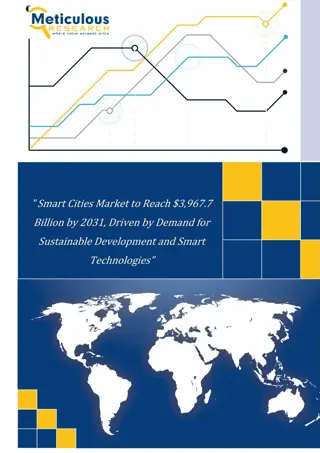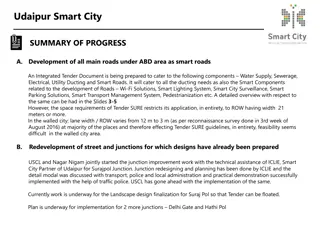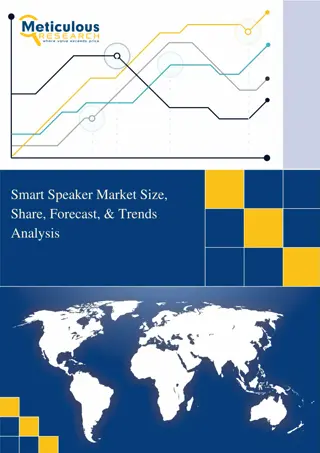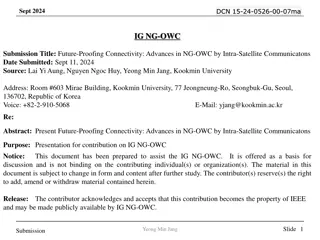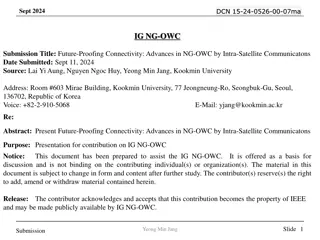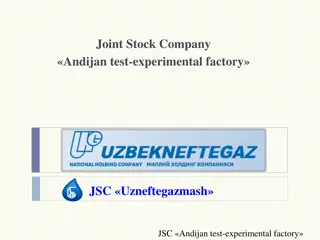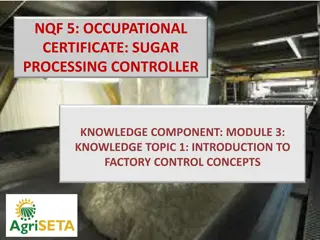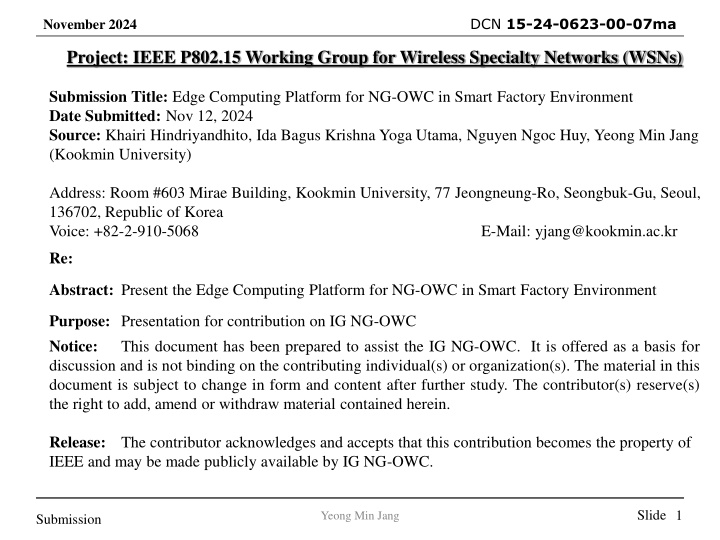
Next-Gen Edge Computing Platform for Optimal Smart Factory Performance
Explore the innovative integration of Edge Computing and NG-OWC technologies in smart factories to enhance operational efficiency, real-time monitoring, and decision-making processes. Uncover how this fusion overcomes conventional communication limitations, ensuring low latency, high reliability, and seamless automation for fully optimized smart factory environments.
Download Presentation

Please find below an Image/Link to download the presentation.
The content on the website is provided AS IS for your information and personal use only. It may not be sold, licensed, or shared on other websites without obtaining consent from the author. If you encounter any issues during the download, it is possible that the publisher has removed the file from their server.
You are allowed to download the files provided on this website for personal or commercial use, subject to the condition that they are used lawfully. All files are the property of their respective owners.
The content on the website is provided AS IS for your information and personal use only. It may not be sold, licensed, or shared on other websites without obtaining consent from the author.
E N D
Presentation Transcript
DCN 15-24-0623-00-07ma November 2024 Project: IEEE P802.15 Working Group for Wireless Specialty Networks (WSNs) Submission Title: Edge Computing Platform for NG-OWC in Smart Factory Environment Date Submitted: Nov 12, 2024 Source: Khairi Hindriyandhito, Ida Bagus Krishna Yoga Utama, Nguyen Ngoc Huy, Yeong Min Jang (Kookmin University) Address: Room #603 Mirae Building, Kookmin University, 77 Jeongneung-Ro, Seongbuk-Gu, Seoul, 136702, Republic of Korea Voice: +82-2-910-5068 E-Mail: yjang@kookmin.ac.kr Re: Abstract: Present the Edge Computing Platform for NG-OWC in Smart Factory Environment Purpose: Presentation for contribution on IG NG-OWC Notice: This document has been prepared to assist the IG NG-OWC. It is offered as a basis for discussion and is not binding on the contributing individual(s) or organization(s). The material in this document is subject to change in form and content after further study. The contributor(s) reserve(s) the right to add, amend or withdraw material contained herein. Release: The contributor acknowledges and accepts that this contribution becomes the property of IEEE and may be made publicly available by IG NG-OWC. Slide 1 Yeong Min Jang Submission
DCN 15-24-0623-00-07ma November 2024 Edge Computing Platform for NG- OWC in Smart Factory Environment Nov. 12, 2024 Slide 2 Yeong Min Jang Submission
DCN 15-24-0623-00-07ma November 2024 Contents Background Current Problems NG-OWC in Smart Factory Environment NG-OWC with Edge Computing Architecture in Smart Factory Environment Conclusion Slide 3 Yeong Min Jang Submission
DCN 15-24-0623-00-07ma November 2024 Background The growth of IoT in recent years has pushed factories to shift into smart factories by integrating a lot of sensors into its premise. Smart factories aim to create an interconnected environment where machinery, devices, and humans work seamlessly to improve efficiency. With more connected devices and equipment, a needs for a timely, effective decisions needs to be made, however relying solely on centralized cloud can lead to latency issues and increase in cost. Slide 4 Yeong Min Jang Submission
DCN 15-24-0623-00-07ma November 2024 Edge Computing and NG-OWC Edge Computing brings computational power closer to where data is generated, allowing for faster processing, low latency, and reduced cloud dependency. Next-Generation Optical Wireless Communication (NG-OWC) provides high-speed, interference-free communication through optical links, well-suited for data-heavy environments like factories. By combining Edge Computing with NG-OWC, smart factories can overcome limitations of conventional wireless communication, achieving low-latency, high-reliability data transmission and processing. This integration supports real-time monitoring, efficient automation, and better operational decision-making, moving towards the ultimate goal of fully optimized, self-adjusting smart factories. Slide 5 Yeong Min Jang Submission
DCN 15-24-0623-00-07ma November 2024 NG-OWC in Smart Factory Environment Sensors CCTV OCC Communication Multi-Object Tracking Early Fire Detection Temperature Humidity Anomaly Detection Intruder Detection PM 2.5 The figure illustrate the implementation of OCC to enable a real-time data transmission between various sensors. With utilizing CCTV as the OCC receiver, allowing a seamless data transmission and providing a robust communication link. Since in a factory environment, sometimes a machinery could cause electromagnetic interference. Slide 6 Yeong Min Jang Submission
DCN 15-24-0623-00-07ma November 2024 NG-OWC with Edge Computing Architecture in Smart Factory Environment OWC Communication Sensors Edge Server Cloud Server Lightweight AI for image detection Application services AI-based Anomaly detection Actuator Monitoring Real-time AI prediction Supervising Sensors Local database Actuator This architecture integrates NG-OWC with Edge Computing to create a high- performance, low-latency data processing environment tailored for smart factories. It allows critical data to be processed at the edge while leveraging cloud resources for additional monitoring and application services. Slide 7 Yeong Min Jang Submission
DCN 15-24-0623-00-07ma November 2024 NG-OWC with Edge Computing Architecture in Smart Factory Environment The Edge Server is responsible for local processing, reducing dependency on cloud communication, and enabling real-time responses. Lightweight AI for Image Detection performs real-time image analysis directly at the edge, enabling fast detection of objects or hazards. AI-based Anomaly Detection monitors sensor and CCTV data to detect unusual patterns, helping to prevent equipment failures or safety incidents. Real-time AI Prediction provides predictive insights based on historical and real-time data to support proactive decision-making. Local Database stores critical data locally for immediate access and processing, ensuring operational continuity even during network disruptions. The cloud offers centralized resources for monitoring and management, allowing for additional scalability and storage. Slide 8 Yeong Min Jang Submission
DCN 15-24-0623-00-07ma November 2024 Conclusion By integrating NG-OWC with edge computing, the architecture enables low-latency, real-time processing essential for smart factory operations. Reliable and Interference-Free Communication with NG-OWC provides a robust, interference-resistant communication solution, ensuring consistent data transmission even in challenging industrial environments. AI-Driven Insights at the Edge, lightweight AI at the edge supports anomaly detection, predictive maintenance, and real-time decision- making, reducing reliance on cloud resources and enabling faster responses. The architecture is scalable and can adapt to future needs, including integration with additional AI and IoT technologies, supporting the continuous evolution of smart factory environments. Slide 9 Yeong Min Jang Submission
DCN 15-24-0623-00-07ma November 2024 References 1. Van Hoa, N., Nguyen, H., Nguyen, C. H., & Jang, Y. M. (2020, October). Occ technology-based developing iot network. In 2020 International Conference on Information and Communication Technology Convergence (ICTC) (pp. 670-673). IEEE. Ahmed, M. F., Hasan, M. K., Chowdhury, M. Z., Hoan, N. C., & Jang, Y. M. (2021). Continuous status monitoring of industrial valve using OCC-enabled wireless sensor network. IEEE Transactions on Instrumentation and Measurement, 71, 1-10. Herfandi, H., Sitanggang, O. S., Nasution, M. R. A., Nguyen, H., & Jang, Y. M. (2024). Real-Time Patient Indoor Health Monitoring and Location Tracking with Optical Camera Communications on the Internet of Medical Things. Applied Sciences, 14(3), 1153. Valinejadshoubi, M., Moselhi, O., Bagchi, A., & Salem, A. (2021). Development of an IoT and BIM-based automated alert system for thermal comfort monitoring in buildings. Sustainable Cities and Society, 66, 102602. Li, L., He, Y., Zhang, H., Fung, J. C., & Lau, A. K. (2023). Enhancing IAQ, thermal comfort, and energy efficiency through an adaptive multi-objective particle swarm optimizer-grey wolf optimization algorithm for smart environmental control. Building and Environment, 235, 110235. 2. 3. 4. 5. Slide10 Yeong Min Jang Submission


